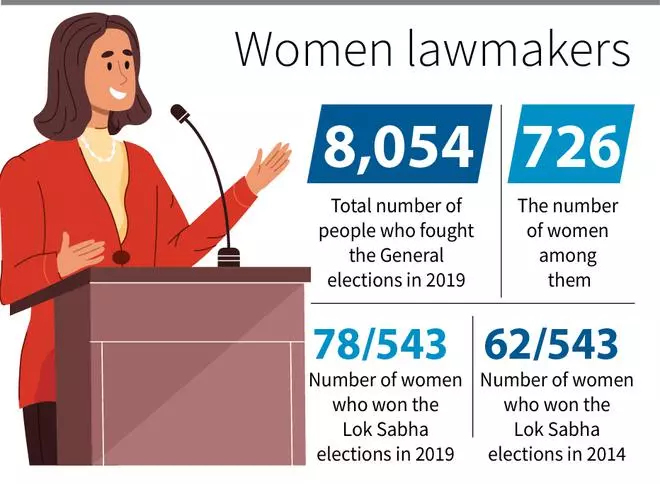Just 78 Lok Sabha constituencies sent women to the Parliament in 2019, making the proportion of women Lok Sabha MPs 14 per cent. The implementation of the much-debated Women’s Reservation Bill 2023 could bring this number up to 179. The bill that was tabled in the Parliament on Tuesday proposes a 33 per cent reservation for women in Lok Sabha and Assemblies of State and National Capital Territory of Delhi, for 15 years.

To get 33 per cent women MPs and MLAs, we need to have adequate number of women contesting the elections. Did enough women candidates stand for Lok Sabha and State assembly elections in the past?

Low participation...
Data from the Election Commission of India shows that in the 2019 Indian general elections, only 726 out of the 8,054 candidates were women, which means that only 9 per cent of the tickets were given to women. Close to a third of these women weren’t backed by any political party. In 2014, the number of women candidates was just 668 among the total 8,251 candidates.

In 2019, BJP, the largest political party, had only 12.5 per cent of the constituencies it was fighting represented by women. The Indian National Congress comes close with 12.8 per cent of tickets given to women. AITC and NTK have, however, done well on this score with 37 per cent and 47 per cent of their Lok Sabha tickets in 2019 given to women candidates.
...and low representation
Do the electorate vote for women candidates? In the 2019 general elections, more than 75 per cent of the voters from Gujarat’s Surat voted in favour of BJP’s Darshana Jardosh. In the same period, Jothimani S, the Indian National Congress candidate from Karur in Tamil Nadu won the elections, with 63 per cent of the people voting for her. However, people who voted for women are a rarity.

Darshana Jardosh

S Jothimani, Lok Sabha MP from Karur
While 78 women won the elections in 2019, just 51 had the majority votes. That list also includes MPs like Pragya Singh Thakur, Hema Malini, Kanimozhi Karunanidhi and Sonia Gandhi.
Voting pattern in States
A look at the data shows that among the larger States, only Odisha has a healthy representation of women. A third of the State’s Lok Sabha members, 7 out of 21, are women. The proportion is also healthy in smaller States like Meghalaya and Tripura, but they have just two Lok Sabha constituencies each. In 13 States, less than 10 per cent of the MPs are women. This list includes Tamil Nadu and Kerala.
Seven States did not send a woman to the Parliament in 2019. Among them, in Manipur and Nagaland, no woman fought the 2019 elections.
Where are the women MLAs?
Currently, the proportion of women MLAs in every State in the country is less than 16 per cent. Among the larger States, West Bengal fares better than others, with 14 per cent of its MLA population being female.
The proportion is less than 10 per cent in 17 States, including Karnataka, Telangana and Tamil Nadu. Mizoram has no women MLAs.




Comments
Comments have to be in English, and in full sentences. They cannot be abusive or personal. Please abide by our community guidelines for posting your comments.
We have migrated to a new commenting platform. If you are already a registered user of TheHindu Businessline and logged in, you may continue to engage with our articles. If you do not have an account please register and login to post comments. Users can access their older comments by logging into their accounts on Vuukle.